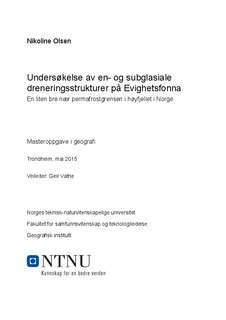| dc.description.abstract | During the summer of 2014 six dye-tracer tests were conducted in two englacial channels in the accumulation area of Evighetsfonna, Oppdal. The aim of this research was to map the drainage system of the glacier. Tests revealed multi-peaked tracer return curves, low velocities and high dispersivities, indicating an inefficient drainage system covering a part of the glacier bed. Dye-tracer tests were conducted both during daytime and in the afternoon and registered by a data logger during the night in channel 1 to examine any diurnal difference in drainage. These tests revealed diurnal variation in the drainage structure of channel 1 which showed abnormal results compared to tests conducted at daytime. Here an inefficient, braided subglacial drainage system is registered during the night reflected by low through-flow velocities and multi-peaked tracer return curve in channel 1 during nighttime. The drainage network of channel 1 thus provide long travel distance for the meltwater. Lower dispersivities are registered during the night in channel 1 meaning that the drainage network covers a smaller part of the glacier bed. There is a marked difference in the characteristics of the two channels investigated, where channel 2 shows low trough-flow velocities, and dispersivity nearly five times lower than in channel 1. The tracer return curves from channel 2 reveal relatively symmetric curves that do not develop through the period of investigation. The subglacial drainage system of Evighetsfonna is revealed to be complex with channelization and well-developed braided channel structure reflected in the multi-peaked tracer return curves. Compared to other non-temperate glaciers, the small glacier Evighetsfonna shows highly complex subglacial drainage structure with low trough-flow velocities, and inefficient drainage capacity. The diurnal test conducted in channel 1 shows that the drainage structure in a non-temperate glacier can change from poorly developed to more efficient over a short
time-span. | nb_NO |
